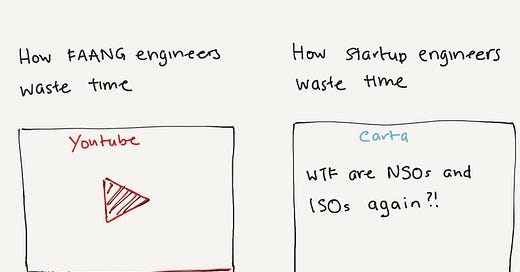Early employees should consider early exercise
A mental model for early exercise benefits and risks
When I joined Scale as the ~20th hire, taxes on my options grant were the least of my worries. It was only later that I (and most of my coworkers) realized the insanely large tax advantage that early exercise provides and wondered why we hadn’t heard of it before.
This post is intended for early startup employees (<$30M raised, <30 people) who believe in their company and have some cash, and for founders who want early hires to share more of the upside. This post is intended to motivate employees to seriously consider negotiating for early exercise. I sketch out the basic ideas and provide some links to more detailed sources at the end.
I’m an engineer, not a lawyer or tax accountant. This is not legal advice or tax advice.
What is early exercise?
In layman’s terms, early exercise is exercising your stock options before they vest. If you’re awarded 10,000 stock options that vest over 4 years (1/4 after 1 year cliff, then 1/48 every month) at $0.80 strike price and you early exercise before the 409a valuation increases, then you pay $8,000 to early exercise and do not incur any taxes until you sell the stock (as long as the 409a value has not changed!). The vesting schedule remains the same, so you own 2,500 shares after your first year and so on. If you leave the company before your grant is fully vested, then the company has the option to buy back your unvested shares (at the strike price you paid).
When early exercise is not offered, employees exercise options after the stock vests (later, I will refer to this as “default” exercise). As the company’s valuation goes up and assuming you have meaningful equity (eg: enough to hit AMT), the taxes you will owe upon exercise increase proportionally to the company’s valuation (eg: if valuation increases exponentially, then so do your taxes!). Note that due to AMT, this tax burden exists for both ISOs and NSOs.

Exercising options matters because
more earnings can be taxed as long-term capital gains, not ordinary income
you can start the clock earlier on long-term capital gains
you can qualify for QSBS (which exempts you from paying federal taxes entirely)
you can leave the company when you want, with your equity
If you have “default” exercise and want to leave with your options, you will need to
dig into your personal savings to pay tax
work with a loan company to pay tax (this incurs additional costs and is only available for later stage companies)
wait until a liquidity event
The last option on the list doesn’t seem terrible until you consider that companies can take ten or more years to go public (such as Airbnb, Unity, Asana, Palantir) so you may be handcuffed into remaining at the company for much longer than you are happy with.
My mental model for early exercise is
Don’t risk cash that you cannot afford to lose.
Assuming you work at this startup because you believe it has the highest expected value among alternatives, then this seems like the best way to bet on your assessment and your own work.
Your upside increases by 15-30%, because of the difference between long-term and short-term capital gains tax rate and the QSBS tax benefit.
Your downside is likely much less than the exercise cost since if you leave before fully vesting, the company will likely (not guaranteed!) buyback all of your unvested options.
You avoid a lot of really shitty situations
The shitty situations include: a. the company raises a big round before your 1 year, so you have to pay taxes on the increase while losing out on QSBS (this happened to me) b. wanting to leave the company but not having enough money to exercise options (also common) c. spending inordinate amounts of time talking with loan brokers, equity brokers, lawyers and reading about tax law (also very common)
When you’re scaling a startup, arcane tax law is not top of mind. But knowing your options matters, because it is the difference between having the freedom to exit after your years of service with all of your vested options vs being stuck at the company due to your millions in un-exercised paper money. Obviously, this assumes that the company does well, which we will talk about later.
Why do founders not offer it?
I’ve asked founders and VCs why more companies don’t offer it. The theme is: some founders don’t know about this, some founders prefer to use the industry norm instead of trailblazing, some founders have this low on their list of priorities, some founders don’t have to because potential hires don’t demand it. ¯\_(ツ)_/¯
My current company (Elementl) does offer it and the team takes advantage of it.
Who should early exercise?
These are extrapolated from the mental model above. You should strongly consider early exercise if these assumptions describe you:
You joined early enough that the total cost is low and you have the cash.
You do not need to take out a loan, you are not paying off other loans, you can comfortably meet your financial obligations. Do consider how losing the sum could reduce your optionality down the road. Do some expected value computations if the cost is medium to high. Note: you can negotiate a signing bonus to cover the early exercise cost.
You prefer to make all-in bets.
You evaluated the space of all startups and decided that this was the best option, so this is a bet on your analysis. You plan to commit 100% of your time and energy to this company, so this is a bet on your ability to grow the team, grow the customer base, build the product.
Benefits of early exercise
The freedom to leave the company with your vested equity without needing to pay taxes on paper gains.
You start the clock on long-term capital gains immediately instead of having to wait for your options to vest and be exercised.
QSBS: If your company has <$50 million in gross assets and fulfills some other requirements at the time of early exercise, then your stock qualifies for $0 federal tax for the first $10MM in gains. The qualification starts when your option is exercised, not when it vests so early exercise should greatly increase the amount of qualified stock.
In terms of “quality of life”, early exercise frees you from continuously evaluating whether or not to exercise options (and pay the corresponding taxes on paper gains) every day/week/month/quarter/year. As IPO approaches, you will end up spending considerable time and energy dealing with your equity; early exercise eliminates this.
Risks
You risk losing the entire cost of early exercise. However, if you early exercise and then leave, the company will likely repurchase unvested options and return much (or all, if you quit before vesting anything) of your initial capital. This is common practice but not guaranteed.
If you early exercise and then leave the company, the company will usually buy back your unvested stock. Say you paid $8000 to early exercise 10,000 options that vest linearly over 4 years and you decide to quit at the end of your first year. Then, you leave with 2,500 shares and the company will usually pay you $6,000 for the unvested 7,500 shares.
To reap the full tax benefits, you should early exercise before the 409a value changes (since you will be taxed on that difference). Companies are required to re-evaluate the 409a every year and on significant financial events, such as a raising a new round.
When should you early exercise?
There is a timing element to early exercise. Ideally, you want to gather as much information about the team/business/market and make your decision right before the new 409A evaluation.
Natty, author of the semistructured blog, shared his decision tree:
Do I believe that a funding round or liquidity event is coming soon? If no, maybe wait to gather more information on how the company is doing
If I early exercise, can I guarantee that this stock will be QSBS? If yes, early exercise as much as possible
Do I have information suggesting that a funding round, or liquidity event is likely to happen soon? If yes, and I have cash that can be spared, early exercise
My experience
Early exercise was not on my radar when I joined Scale. Instead, I exercised my first year of vested options a week after an order of magnitude increase in valuation, meaning mid 5-figures in taxes and missing the ~20% tax benefit of QSBS.
Elementl, the company behind dagster.io, does encourage all employees to early exercise and works with hires to make it financially feasible. I hope that this becomes the industry standard. (If you are passionate about open-source, data orchestration, building a cloud product from the ground up, here’s our open roles.)
If this was helpful and you would like to see in-depth discussions about how early exercise plays out in various scenarios, email me at itscatwu@gmail.com.
Further reading
https://carta.com/blog/exercising-stock-options/#what-is-early-exercising
https://medium.com/swlh/understanding-startup-stock-options-4bf9cc26089e
https://www.investopedia.com/terms/q/qsbs-qualified-small-business-stock.asp
Thank you
Thank you Natty for giving me great feedback. He writes about the data space, open source, and personal finance here: https://semistructured.substack.com/
Thank you Sam and Jimmy for being wonderful editors!





"Then, you leave with 2,500 shares and the company will usually pay you $6,000 for the unvested 7,500 shares."
What is the alternative? If I'm not there anymore, the remaining shares will never vest. Can the company just keep the $6,000 and I get nothing in return?
while totally irrelevant to my current position as a student... I am really glad I read this and now will hopefully have this top of mind when I join a startup in the future. Gives me something to save towards haha (was never a car or house "fund" guy but maybe I could have an "early exercise to take advantage of QSBS and bet on myself and judgement" "fund".